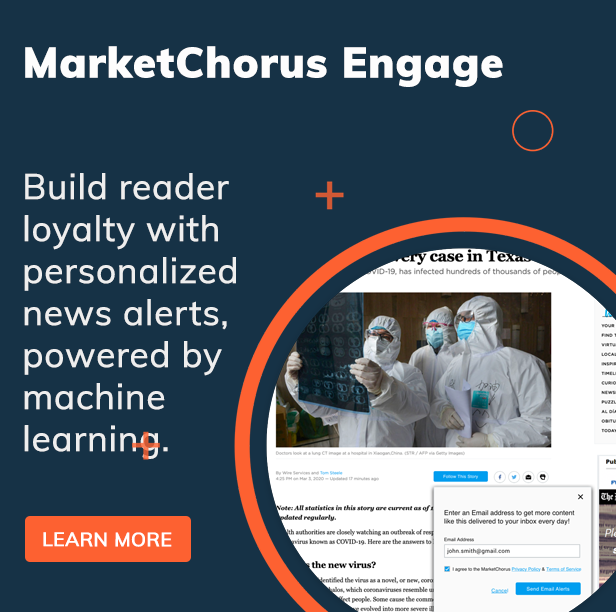Over the last 10 years more than $30B of ad revenues left traditional media in favor of the Google / Facebook duopoly (Source: USA Today).
Due to privacy, ad fraud, and declining click-through-rates (CTRs) across all industries (Source: AdStage), digital advertising is at a major turning point. Contextual data, which publishers control, will be a premium value in years to come.
More to the point, either due to a lack of technology, limited viewership, or declining reach, publishers are typically selling out owned media 100% of the time and, at fairly minimal CPMs. This leaves ad sales teams trying to grow digital revenues in bits and pieces, without a strong, differentiated product.
Jim Collins’ fantastic book, “Good To Great”, introduced the seminal idea of the “hedgehog concept” -the activity a brand does better than anyone else and can reliably monetize.
If you’re a publisher, your “hedgehog concept” has always been providing high-quality content to subscribers and high-quality audiences to display advertisers. Nothing has changed.
But print advertising revenues are insufficient on their own, despite the fact that the decline in print revenues has been steadily slowing over the last 4 years (Source: Statista). Regardless, print subscription rates are not growing but digital subscriptions are…
The monetizable audience of the future is clearly online.

While strides have been made to grow digital audiences, revenues are still falling across the industry. New revenue streams are still needed to stabilize and grow. Prior attempts to diversify have met a variety of challenges and the problem remains.
Rather than pivoting further away from your traditional strengths, why not lean in?
There is a much wider marketplace to benefit from than just the pay-walled structures of your owned media.
Facebook owns the majority of the available digital audience…but they don’t know everything about that audience that you do. You know what people read, and thus, can infer what interests and concerns them; how they plan, what they like to do, eat, and watch, and more.
Much like Facebook, you’re the ecosystem in which the activity is happening (on your website). But after your visitors are done reading, they leave. Facebook stays with them nearly all the time…
Annually, Facebook will garner significantly more of their time and attention than your content -but your content is rich with context, and yields more valuable insights than the snackable, meme-filled content typically found on social networks.
This gives you an opportunity to monetize your audience while they’re on Facebook.
Not just sponsored posts or typical Facebook ads that literally anyone can run…
Your secret weapon is the audience you share with Facebook. Everyone that visits your site while logged into Facebook can be automatically added into a custom retargeting audience in your Facebook Ad Manager.
That’s nothing new in itself…but here’s the part you’ve never heard before:
MarketChorus allows you to create highly-specific custom audiences by intersecting segments of your readers based on their viewing habits.

Stay with me, this is where it gets good…
Imagine a Venn diagram where the left circle contains your arts & entertainment readers and the right circle contains your investment column readers. The overlap between the two (arts and entertainment readers with investment capital) is a prime audience of potential donors that you could sell to your symphony, opera house, or art museum customers.
Imagine another Venn where the left circle is your real estate audience and the right circle is readers of articles about new companies moving into town. With the right curation, this audience could contain a very valuable list of local commercial real estate developers and brokers.
We call these overlapping segments of hyper-targeted audiences, “intersects”, and they represent the strategic advantage that MarketChorus provides to publishers, in a nutshell.
No one else has this data.
No one else can sell this advertising product. And what’s more? Campaigns using hyper-targeted custom audiences like these tend to convert at 4-5x typical Facebook campaigns.
4x+ higher CTR and up to 30% lower cost-per-lead (CPL) are the kind of results our customers are receiving from contextual retargeting audiences generated by the MarketChorus Engage platform.
So what, you say, if we’re delivering cheaper clicks for customers? How does that help us drive more scalable revenue?
This is what we typically recommend:
- By using your own retargeting audiences you’re avoiding paying Facebook a sizeable data fee that is buried in typical campaign costs. Charge a data fee to your customers to create additional margin.
- Generate your data fee from Facebook ad benchmarks like this:
Avg CPM: $7.77 (Source AdStage)
Your retargeting CPM: $4.50
Data fee (your margin): $3.27
Total Spend: $2,500
Impressions at $7.77: 321,750
Your cost at $4.50: $1,448
Profit: $1,052 or 42%
And keep in mind, that you can still charge your typical management fee.
And you can still use Facebook analytics (without spend) to generate any reports you need for the client because you’ll always deliver the right number of impressions, just at a much lower cost to you.
Your actual numbers will vary between campaigns. Sometimes our customers run ads to high value segments and the cost-per-lead actually goes up but the lead quality increases and therefore the cost-per-acquisition (sale) goes down -and that’s never a bad thing.
Running these ad campaigns is extremely easy. Easier than typical Facebook campaigns. And if you don’t already have the resources internally, we can help you there as well.
There’s money on the table and Google and Facebook are weak in the contextual ad space. It’s time to flex your muscles and grow your share of the ad dollars.
Just let us know when you’re ready to talk.




